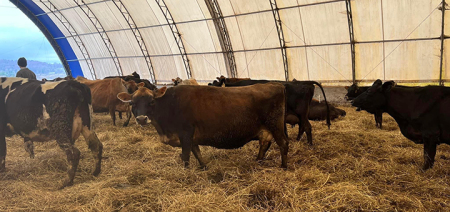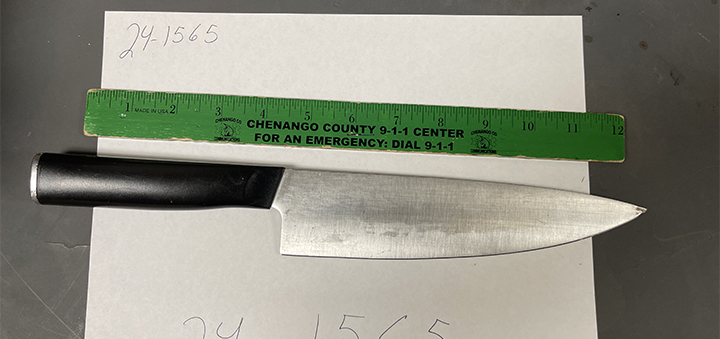Chenango Struggles To Get Enough Testing Kits, Officials Respond To Public’s Questions
Published:
April 1st, 2020
By:
Tyler Murphy
CHENANGO – Tuesday the Chenango County Department of Health confirmed there are now 21 cases of Coronavirus in the county, but officials warned there could be many others since local testing has been limited due to a lack of available supplies.
As of Tuesday about 119 residents are under precautionary quarantine and another 144 are under mandatory quarantine.
NY Governor Andrew Cuomo has touted the state’s ability to complete more than 15,000 tests a day, many of them located in the New York City area. However Chenango officials said they are still struggling to get the local testing kits they need.
“Testing has been limited due to the lack of test kits available to our hospitals,” Director of Environmental Health and Code Enforcement Isaiah Sutton reported.
“These confirmed cases of Coronavirus are not an indicator of the amount of disease in the community. If more tests were available, more individuals would be identified as positive. This is why it is so important to continue to take precautions and protect ourselves from the virus,” he stated.
The Chenango County Department of Heath has not recently said how many residents have been tested. The last time officials released a figure was on March 13 when Public Health Director Marcas Flindt said about a dozen people had been tested.
Officials have not responded to requests, made last week, for estimates on the number of people being tested and already tested locally.
Sutton recommended, “Please remain vigilant. Follow the recommendations to protect yourself and others from COVID-19. This will help reduce the spread of the virus and keep yourself and our community healthy.”
Officials offered these tips:
- Wash your hands and cover your coughs. Clean and disinfect frequently.
- Practice “social distancing” by staying at home, keeping a 6 foot distance from others, and avoiding gatherings.
- Protect those most at risk. Avoid visiting those at health risk, offer help in getting supplies for at risk people, and take special caution to avoid exposing them by keeping a 6 foot distance.
- Cough or sneeze into a tissue then dispose of it appropriately, or into your elbow if you don’t have a tissue.
- If you’re sick, do not go to work and monitor your symptoms.
Commonly asked questions from Chenango County residents about COVID-19
This is a rapidly evolving situation and information is subject to change. The following responses were recently provided by the Chenango County Department of Health.
What is a confirmed case?
An individual is a confirmed case when they are tested positive for the virus. The person is presumed to be contagious. A contact investigation begins in order to determine others who may have been exposed. The individual remains in isolation (away from all others) until a medical professional releases them, and they are no longer contagious. For the general public, a positive case brings awareness that the virus is present in the community, but does not mean that everyone is at risk of exposure. Sharing location of positive cases does not change what the general public should do: Stay home, adhere to social distancing, and wash hands well and often.
What is a contact investigation?
An investigation is the process of identifying anyone who may have come into contact with the person who tested positive for COVID-19. The positive person is interviewed by a public health nurse about places they have been, and asked to list people who may have been in close contact. A close contact is within 6 feet of someone for a long period of time or direct contact with secretions via cough, sneeze, or speaking. The contacts are notified that they may have been exposed. To protect the privacy of the individual, the Health Department cannot release identifying information. The contacts of the positive individual will be contacted by a public health nurse as part of the contact investigation.
If the confirmed case was at a large gathering or public location, public notice would be sent out with directions about who to contact, via press releases, social media, and other channels to assure as wide a distribution as possible.
What is precautionary quarantine?
Precautionary Quarantine is required and directed by the local health department for the following persons:
Travel to a highly affected area and are not sick. NYS considers any county that has a CDC-designated travel warning level of ‘3’ (avoid nonessential travel) and level ‘2’ (practice enhanced precautions) as countries that are highly affected by COVID-19. Lists of Countries with travel warnings can be found at cdc.gov.
‘Proximate exposure’ to a confirmed case who tested positive for the virus that causes COVID-19 in a congregate setting (e.g., within more than 6 feet such as at social gatherings, conferences, etc.), and not sick. If this person develops symptoms of fever cough, and difficulty breathing, they will be placed under Mandatory Quarantine.
Any other person whose healthcare provider and local health department believes should be quarantined.
What is mandatory quarantine?
Mandatory Quarantine is required and directed by the local health department by a quarantine court order. This is required for the following persons:
Persons who tested positive for the virus that causes COVID-19 by a clinical test (regardless if they are symptomatic or not).
Persons who had direct contact (within 6 feet) with a confirmed case who tested positive for the virus that causes COVID-19 (regardless if they are sick or not).
Persons who traveled to a highly affected area, and have symptoms of fever, cough, and trouble breathing. NYS considers any county that has a CDC-designated travel warning level of ‘3’ (avoid nonessential travel) and level ‘2’ (practice enhanced precautions) as countries that are highly affected by COVID-19.
Any other person whose healthcare provider and local health department believe should be quarantined.
Face masks. Should i wear a face mask to prevent getting COVID-19?
CDC does NOT recommend that the general public use face masks. Instead, people should cover their coughs and sneezes, stay home when sick, and wash their hands often and thoroughly. However, if you are sick with COVID-19 (or any respiratory illness), you should wear a face mask before going inside a healthcare provider’s office or a hospital. If you are caring for someone who is sick you should wear a face mask when you enter their room.
Children: can children get COVID-19?
According to CDC, children can develop COVID-19 but they tend to have much milder symptoms than older adults. It is not yet known for certain whether or not children with underlying health conditions who develop COVID-19 are at risk for having more severe illness.
Pregnancy: are pregnant women more at risk for COVID-19?
We do not currently know if pregnant women have a greater chance of getting sick from COVID-19 than the general public nor whether they are more likely to have serious illness as a result. Pregnant women experience changes in their bodies that may increase their risk of some infections. With viruses from the same family as COVID-19, and other viral respiratory infections, such as influenza, women have had a higher risk of developing severe illness. It is always important for pregnant women to protect themselves from illnesses. We still do not know if a pregnant woman with COVID-19 can pass the virus that causes COVID-19 to her fetus or baby during pregnancy or delivery.
Breastfeeding: should breastfeeding mothers be concerned about COVID-19?
Breast milk is the best source of nutrition for infants. However, much is unknown about COVID-19. Whether to start or continue breastfeeding should be determined by the mother in coordination with her healthcare provider. It is not currently known if COVID-19 is transmitted from breastfeeding mothers to their children. If a mother is positive for COVID-19, she may have to take extra precautions to avoid spreading the virus to the infant. In some limited studies, the virus has not been detected in breastmilk.
Pets: Should I be concerned about pets or other animals and COVID-19?
While this virus seems to have emerged from an animal source, it is now spreading from person-to-person. While CDC recommends that people traveling to affected countries avoid animals both live and dead, there is no reason to think that any animals or pets in the United States might be a source of infection. CDC has not received any reports of pets or other animals becoming sick with COVID-19.
Social distancing: what are some examples of social distancing?
Not shaking hands, hugging or kissing when greeting people. Limiting visitors. Maintaining at a least six feet apart from others. Avoiding mass gatherings. Working at home. Closing schools and providing remote learning instruction to students
Treatment: can COVID-19 be treated?
There is no specific antiviral treatment recommended for COVID-19 and there is currently no vaccine. People infected with the virus that causes COVID-19 should receive supportive care to help relieve symptoms. For severe cases, treatment in a hospital might be required. Work with your healthcare provider for recommendations.
What are the symptoms of COVID-19?
COVID-19 can cause mild to severe respiratory illness with symptoms of fever, cough, and difficulty breathing. Preliminary information suggests older adults and people with underlying health conditions or compromised immune systems may be at higher risk of severe illness from this virus. CDC believes that symptoms of COVID-19 begins between 2 and 14 days after exposure.
How does COVID-19 spread?
While the initial transmission is believed to have been animal-to-person spread, COVID-19 is now spreading from person-to-person. This is thought to occur via respiratory droplets produced when a person infected with the virus coughs or sneezes, the same way flu and other respiratory illnesses spread. The virus that causes COVID-19 can also be transmitted for 2-3 days if people touch surfaces and objects with the virus on it.
When are people most contagious?
People with COVID-19 are believed to be most contagious when they are showing symptoms. Some early research shows that individuals with mild COVID-19 might be contagious even before they have symptoms, but it is not clear how common this is.
What is community spread?
Community spread means people have been infected with the virus in an area, including people who are not sure how or when they became infected. COVID-19 seems to be spreading easily and continually in the community.
Who is at risk for getting COVID-19 in the united states?
In the United States, cases have been reported in almost all states. People in communities where ongoing community spread is reported, healthcare workers, close contacts of persons with COVID-19, and travelers returning from affected international locations ARE at risk of getting COVID-19.
High risk: who is at highest risk for getting very sick from COVID-19?
According to limited research, older adults (65 plus), people who have chronic medical conditions, and people who are immunosuppressed are at higher risk for serious illness from COVID-19. Some examples of chronic medical conditions are heart disease, diabetes, lung disease, moderate or severe asthma, renal failure, liver disease, and severe obesity.
Many conditions can cause a person to be immunocompromised, including cancer treatment, bone marrow or organ transplantation, immune deficiencies, poorly controlled HIV or AIDS, and prolonged use of corticosteroids and other immune weakening medications.
Seasonality: will warm weather stop the spread of COVID-19?
It is not yet known whether weather and temperature impact the spread of COVID-19. Some other viruses, like the common cold and flu, spread more during cold weather months, but it is still possible to become sick with these viruses during other months. At this time, it is not known whether warmer weather will slow the spread of COVID-19.
For more information about COVID-19 go to www.cdc.gov/coronavirus
Author: Tyler Murphy - More From This Author
Comments





(1).jpg)

